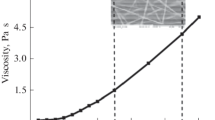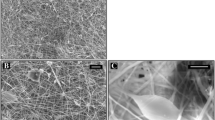Abstract
The structure and diffusion properties of combined ultrafibrous matrices containing microspheres for prolonged release of lysozyme are studied in the work. The matrices are biocompatible and they are not cytotoxic. The matrices are obtained via electrospinning. These materials are suitable for solving problems of tissue engineering, since they combine ultrafine fibers of poly(hydroxybutyrate) promoting effective attachment and growth of cells and poly(hydroxybutyrate) microparticles capable of prolonged release of a bioactive compound. These properties allow one to recommend these matrices for tissue engineering.






Similar content being viewed by others
REFERENCES
Bonartsev, A.P., Bonartseva, G.A., Shaitan, K.V., and Kirpichnikov, M.P., Poly(3-hydroxybutyrate) and poly(3-hydroxybutyrate)—based biopolymer systems, Biochem. (Moscow), Suppl. Ser. B: Biomed. Chem., 2011, vol. 5, no. 1, pp. 10–21.
Gunatillake, P.A. and Adhikari, R., Biodegradable synthetic polymers for tissue engineering, Eur. Cells Mater., 2003, vol. 5, no. 1, pp. 1–16. https://doi.org/10.22203/ecm.v005a01
Cao, K., Liu, Y., Olkhov, A.A., Siracusa, V., and Iordanskii, A.L., PLLA-PHB fiber membranes obtained by solvent-free electrospinning for short-time drug delivery, Drug Delivery Transl. Res., 2018, vol. 8, no. 1, pp. 291–302.
Olkhov, A., Gur’ev, V., Akatov, V., Mastalygina, E., Iordanskii, A., and Sevastyanov, V.I., Composite tendon implant based on nanofibrillar polyhydroxybutyrate and polyamide filaments, J. Biomed. Mater. Res., Part A, 2018, vol. 106, no. 10, pp. 2708–2713.
Li, D. and Xia, Y., Electrospinning of nanofibers: Reinventing the wheel? Adv. Mater., 2004, vol. 16, no. 14, pp. 1151–1170.
Haider, A., Haider, S., and Kang, I.-K., A comprehensive review summarizing the effect of electrospinning parameters and potential applications of nanofibers in biomedical and biotechnology, Arabian J. Chem., 2018, vol. 11, pp. 1165–1188.
Ding, J., Zhang, J., Li, J., Li, D., Xiao, C., Xiao, H., Yang, H., Zhuang, X., and Chen, X., Electrospun polymer biomaterials, Prog. Polym. Sci., 2019, vol. 90, pp. 1–34.
Baradaran-Rafii, A., Biazar, E., and Heidari-Keshel, S., Cellular response of stem cells on nanofibrous scaffold for ocular surface bioengineering, ASAIO J., 2015, vol. 61, no. 5, pp. 605–612.
Shtilman, M.I., Polymeric Biomaterials. Part 1. Polymer Implants, Leiden, Netherlands: VSP, 2003.
Satyam, A., Kumar, P., Fan, X., Gorelov, A., Rochev, Y., Joshi, L., Peinado, H., Lyden, D., Thomas, B., Rodriguez, B., Raghunath, M., Pandit, A., and Zeugolis, D., Macromolecular crowding meets tissue engineering by self-assembly: A paradigm shift in regenerative medicine, Adv. Mater., 2014, vol. 26, no. 19, pp. 3024–3034.
Moisenovich, M.M., Pustovalova, O., Shackelford, J., Vasiljeva, T.V., Druzhinina, T.V., Kamenchuk, Y.A., Guzeev, V.V., Sokolova, O.S., Bogush, V.G., Debabov, V.G., Kirpichnikov, M.P., and Agapov, I.I., Tissue regeneration in vivo within recombinant spidroin 1 scaffolds, Biomaterials, 2012, vol. 33, no. 15, pp. 3887–3898.
Chan, L.W. and Heng, P.W.S., Effects of aldehydes and methods of cross-linking on properties of calcium alginate microspheres prepared by emulsification, Biomaterials, 2002, vol. 23, no. 5, pp. 1319–1326.
Hiramatsu, M., Okabe, N., and Tomita, K., Preparation and properties of lysozyme modified by fluorescein-isothiocyanate, J. Biochem., 1973, vol. 73, no. 5, pp. 971–978.
Kim, I.-D., Advances in electrospun functional nanofibers, Macromol. Mater. Eng., 2013, vol. 298, no. 5, pp. 473–474.
Sutherland, M.W. and Learmonth, B.A., The tetrazolium dyes MTS and XTT provide new quantitative assays for superoxide and superoxide dismutase, Free Radical Res., 1997, vol. 27, no. 3, pp. 283–289.
Ol’khov, A.A., Kucherenko, E.L., Kosenko, R.Yu., Markin, V.S., Perov, V.I., and Iordanskiy, A.L., Analysis of the structure of polyhydroxybutyrate-based fibrous matrices for prolonged drug release, Inorg. Mater.: Appl. Res., 2019, vol. 10, pp. 806–811. https://doi.org/10.1134/S2075113319040300
Author information
Authors and Affiliations
Corresponding author
Additional information
Translated by K. Aleksanyan
Rights and permissions
About this article
Cite this article
Bonartsev, A.P., Ol’khov, A.A., Khan, O.I. et al. Matrices for Tissue Engineering Based on Ultrafine Fibers and Microparticles of Poly(hydroxybutyrate). Inorg. Mater. Appl. Res. 12, 974–979 (2021). https://doi.org/10.1134/S2075113321040080
Received:
Revised:
Accepted:
Published:
Issue Date:
DOI: https://doi.org/10.1134/S2075113321040080




